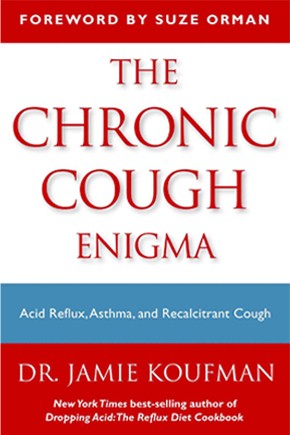At-A-Glance
- Esophageal dysmotility occurs when the esophagus cannot move food or liquid effectively due to weak or disordered muscle contractions.
- Dysmotility is often treated as a primary disorder, but in many cases, the true cause is chronic reflux (GERD or LPR).
- Reflux-driven inflammation disrupts normal esophageal function, leading to a cycle of worsening motility.
- Prokinetic medications may be prescribed, but they often fail to address the root issue and come with side effects.
- When reflux is properly treated and the esophagus is allowed to heal, motility often returns — sometimes even after complete loss.
- A comprehensive reflux protocol that includes diet, lifestyle changes, and targeted support can restore normal esophageal function.
Join Dr Jamie Koufman on Facebook Live at noon EST on the first Wednesday of each Month. If you miss it live, you can also see it on YouTube.
Esophageal Dysmotility: Rethinking the Cause and the Cure
Esophageal dysmotility occurs when the esophagus cannot effectively move food or liquid downward due to disordered or weakened muscular contractions. It’s often treated as a standalone mechanical problem and typically managed with medications intended to stimulate movement.
But in my experience, esophageal dysmotility is rarely an isolated issue. More often, it’s a symptom of a deeper underlying cause: acid reflux — whether esophageal reflux (GERD) or respiratory reflux (LPR). When reflux is fully resolved and the esophagus is allowed to heal, motility doesn’t just improve — it can return to normal.
Understanding the Causes and Diagnosis of Dysmotility
When the esophagus fails to carry out its job — moving food and liquid downward in a smooth, coordinated way — it’s often due to a disruption in peristalsis, the wave-like motion generated by the muscular wall. This disruption can stem from problems in the muscles themselves or in the nervous system that controls them. The result is inefficient, disorganized, or even completely absent contractions.
To evaluate this, gastroenterologists often use a test called esophageal manometry, which measures the pressure and coordination of these muscle movements. While manometry can describe the strength of the esophageal contractions, it doesn’t reveal why they aren’t working properly.
In many cases, no clear explanation is found, and investigation into the cause usually stops there. But this question — what is driving the dysfunction? — is essential.
How Reflux Leads to Esophageal Dysmotility
When the esophagus stops doing its job, the most common reason is reflux. While conventional medicine acknowledges a loose association between reflux and motility disorders, it stops short of identifying reflux as the cause.
From a clinical standpoint, however, I’ve found that esophageal dysmotility is rarely a primary disorder. More often, it’s a response to ongoing inflammation. The longer the tissue is exposed to reflux, the more its function begins to deteriorate — and that loss of function leads to more reflux, creating a downward spiral.
This inflammation doesn’t just affect the esophagus. It also impacts the lower esophageal sphincter (LES) — the valve responsible for keeping stomach contents out of the esophagus. As the LES becomes swollen and dysfunctional, reflux worsens, accelerating the cycle.
Chronic irritation leads to stiffness, loss of tone, and impaired signaling throughout the esophagus. Motility appears to fail — but in most cases, the esophagus still retains the ability to contract. It’s simply suppressed by ongoing inflammation.
One way to observe this connection is through a barium swallow study (esophagram) performed both upright and lying down. This non-invasive imaging test often reveals signs of both reflux and dysmotility, offering a more complete picture than pressure testing alone.
Why Motility Medications Often Fail to Help
In the absence of a clear cause, most gastroenterologists turn to prokinetic medications — drugs that aim to stimulate esophageal or stomach contractions — in an effort to overcome dysmotility.
These include drugs like metoclopramide, erythromycin, and prucalopride. In theory, they’re designed to improve movement through the digestive tract. In practice, prokinetic medications often cause uncomfortable side effects — and more importantly, they fail to address the underlying problem.
I’ve avoided using these medications throughout my career. Why? Because in the vast majority of cases, reflux is driving the dysmotility — and when reflux is treated effectively, the esophagus often begins functioning normally again, without the need for drugs that override the nervous system.
I’ve seen this firsthand many times. But two cases stand out: both patients presented with complete aperistalsis — no measurable movement in the esophagus. They were told the condition was permanent. After completing a comprehensive reflux program, both regained normal esophageal motility. It wasn’t a miracle — it was physiology. We simply removed the source of injury long enough for the body to repair itself.
Natural Treatment for Esophageal Dysmotility: The Reflux Detox
I strongly recommend a structured reflux detox program. If reflux can be fully stopped for four weeks, the esophagus — along with the LES — has a chance to heal and restore its natural function. When that happens, motility often returns on its own.
This four-week healing plan requires consistency and commitment, but it is absolutely achievable. Key components include:
- Reverse intermittent fasting (no late-night eating)
- Sleeping on an incline
- Low-acid, low-fat diet
- Alkaline water
- Alginates to protect the esophageal lining
- Gum after meals to stimulate esophageal clearing
- Famotidine (H2 blocker): 20 mg in the morning, 20 mg before dinner, and 40 mg at bedtime
For a more detailed overview of the full reflux treatment protocol, see A Doctor’s Guide to Treatment of Silent Reflux, Respiratory Reflux, and LPR.
Conclusion: Restoring Motility by Treating Reflux at the Root
Esophageal dysmotility is commonly approached as a disorder in need of management — but in many cases, it is a reversible consequence of untreated reflux. When chronic inflammation is removed, the esophagus is capable of recovering its natural function.
By shifting the focus from symptom control to root-cause resolution, we give the body what it truly needs: the conditions to heal. For those struggling with dysmotility, the most effective path forward often begins not with medication, but with restoring the integrity of the esophagus through comprehensive reflux treatment.
For more information about diagnosis and treatment of acid reflux, see two companion books on Amazon: Dr. Koufman’s Acid Reflux Diet and Dropping Acid: The Reflux Diet Cookbook & Cure. If you would like to receive personalized guidance and strategies for lasting relief, consider scheduling an online consultation.









